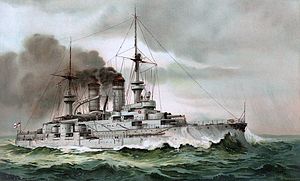
Back Třída Wittelsbach Czech Wittelsbach-Klasse German Clase Wittelsbach Spanish نبردناو کلاس ویتلزباخ Persian Wittelsbach-luokka Finnish Classe Wittelsbach French אוניות המערכה מסדרת ויטלסבאך HE Classe Wittelsbach Italian ヴィッテルスバッハ級戦艦 Japanese Pancerniki typu Wittelsbach Polish
 Lithograph of Zähringen in 1902
| |
| Class overview | |
|---|---|
| Operators | |
| Preceded by | Kaiser Friedrich III class |
| Succeeded by | Braunschweig class |
| Built | 1899–1904 |
| In service | 1902-1944 |
| In commission | 1902–1921 |
| Planned | 5 |
| Completed | 5 |
| Lost | 1 |
| Scrapped | 4 |
| General characteristics | |
| Type | Pre-dreadnought battleship |
| Displacement |
|
| Length | 126.8 m (416 ft) (loa) |
| Beam | 22.8 m (74 ft 10 in) |
| Draft | 7.95 m (26 ft 1 in) |
| Installed power |
|
| Propulsion |
|
| Speed | 18 knots (33 km/h; 21 mph) |
| Range | 5,000 nautical miles (9,300 km; 5,800 mi); 10 knots (19 km/h; 12 mph) |
| Complement |
|
| Armament |
|
| Armor | |
The Wittelsbach-class battleships were a group of five pre-dreadnought battleships built for the German Kaiserliche Marine (Imperial Navy) in the early 1900s. They were the first battleships ordered under the Second Navy Law of 1898, part of Admiral Alfred von Tirpitz's fleet expansion program. The class comprised the lead ship, Wittelsbach, and Wettin, Zähringen, Schwaben, and Mecklenburg. All five ships were laid down between 1899 and 1900 and were finished by 1904. The ships of the Wittelsbach class were similar in appearance to their predecessors in the Kaiser Friedrich III class, but had a more extensive armor belt and a flush main deck, as opposed to the lower quarterdeck of the previous class. Both classes carried a battery of four 24 cm (9.4 in) guns in two twin-gun turrets.
Wittelsbach, Wettin, Mecklenburg, and Zähringen served in I Squadron for the duration of their peacetime careers, where they were primarily occupied with training exercises and cruises abroad. Schwaben was used as a training ship to modernize the training unit of the German fleet. By 1910, with the arrival of the first dreadnought battleships, the Wittelsbach-class ships were removed from front-line service and relegated to training duties or simply laid up in reserve. With the outbreak of World War I in July 1914, the ships returned to active service as IV Battle Squadron, seeing guard duty in the North Sea and limited operations in the Baltic Sea against Russian forces. These operations included supporting the attack on Libau in May 1915 and the Battle of the Gulf of Riga in August that year.
By late 1915, the naval command had decided to decommission the five ships owing to a combination of crew shortages for more important vessels and the increased threat of British submarines operating in the Baltic. The ships were thereafter used as training vessels or, in the case of Mecklenburg, a prison ship. Wittelsbach and Schwaben were converted into depot ships for minesweepers in the postwar effort to clear up the minefields that had been laid in the North Sea. Those two ships, Mecklenburg, and Wettin were stricken from the naval register in the early 1920s and thereafter broken up, but Zähringen was converted into a radio-controlled target ship, a role she filled until she was bombed and sunk by British bombers in 1944 during World War II. The wreck was eventually broken up in 1949–1950.